General
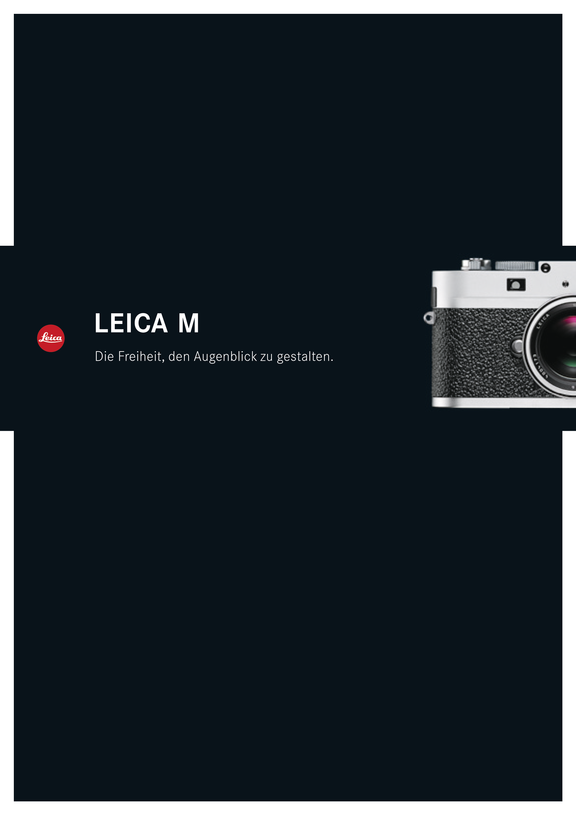
In addition to the guidelines already described in the wording section, several specific features and rules apply to the design and layout of brochures. A range of different text modules is provided to ensure that the design of the brochures is always exciting, entertaining, and informative. Brochures begin with an emotive tonality and become more technical from page to page.
Headlines/Subheadlines
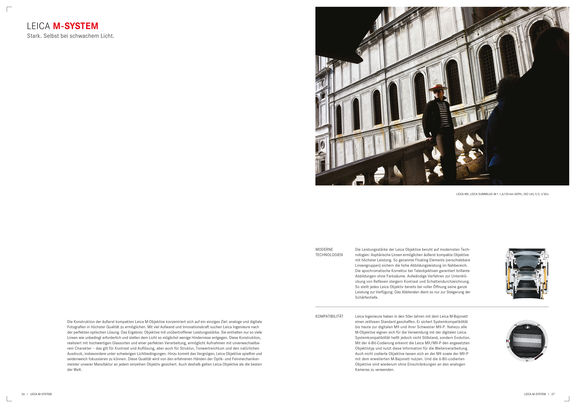
Headlines are set in caps and subheadings in mixed case. Each headline is always followed by a subheading. Only exception: headlines on chapter separators are set without a subheading. Headlines are informative and incisive, concisely summarizing the subsequent content. Subheadings are emotive in content. No punctuation mark is set after headlines. A punctuation mark is set at the end of subheadings.
Examples:
LEICA M
The freedom to capture the decisive moment.
LEICA M-SYSTEM
Unrivaled, even in the lowest light.
Chapter Separators
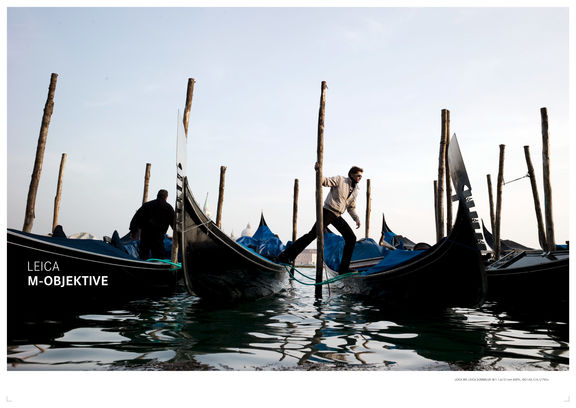
Chapter separators feature a double-page emotive image as visual content, as well as a
factual headline set in caps superimposed on the image. This headline is very short and
incisive, concisely summarizing the content of the subsequent chapter, and is also the
chapter title that appears next to the page numbers of the corresponding chapter.
Examples:
LEICA M9/M9-P
LEICA CAMERAS AND SPORT OPTICS
LEICA M-LENSES
Chapter Intro/Stories
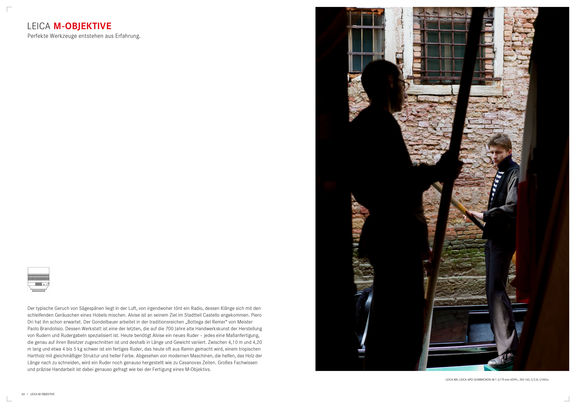
The chapter intro is an emotive introduction to the content of the respective chapter. It narrates the story told by the pictures. Dynamic, authentic, and captivating. By the close of the story, the association with Leica has been successfully established, along with the emotional link between the story and the content of the chapter that follows. The story is the essential part of this text element: the focus is not on the product. Although the chapter intro is emotive in nature, it remains clear and concise and does not wander off topic. This leaves more space for pictures and the white space around them. Along with the text and images, the generous use of white space further highlights the premium aspect of Leica.
Example:
The unmistakable smell of sawdust hangs in the air. A radio is playing somewhere, its music merging with the rhythmic strokes of a wood plane. Alvise has arrived at his destination in the Castello neighborhood. Piero Dri is expecting him. The oar maker works in the Bottega del Remer, the tradition-rich workshop of the master craftsman, Paolo Brandolisio. This is one of the last specialist workshops that follow the 700-year-old craft of producing oars and oar supports. Today Alvise needs a new oar. Each one is tailor-made for the gondolier: the oar’s length can vary from 4.10 to 4.20 meters and each can weigh between 4 and 5 kg. Often, ship are essential – just as with the creation of a Leica M-Lens. The perfect gondola ...
Product Intro
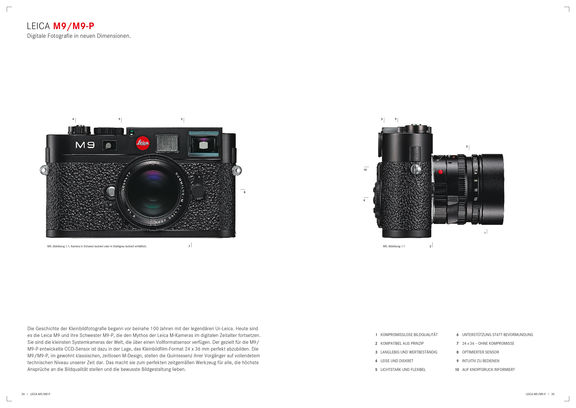
The chapter intro is followed by a section introducing the product: the product intro. This section always begins with a headline and a subheading. The headline is informative and set in caps, while the subheading is emotive and set in mixed case. The product intro is also emotive and appears only once within the chapter. The product intro communicates the philosophy of the Leica brand. It provides an impression of the positioning of the respective camera within the brand portfolio. At the same time, the emotive content of the product text focuses on the product and illustrates its key features and special characteristics. The product intro is always short.
Example:
The history of 35 mm photography began almost 100 years ago with the legendary Ur-Leica. Today, it is the Leica M9 and its sister model, the M9-P, that carry the legend of Leica M-Cameras into the digital age. They are the smallest full-format, digital system cameras the world has ever seen. The CCD sensor, developed specifically for the M9/M9-P, is capable of perfectly capturing the full 35 mm format of 24 × 36 mm. The M9 and the M9-P, in the familiar, classic, and timeless M design, represent the quintessence of their predecessors, but feature the ultimate in technological advancements of our time. This makes them the perfect contemporary tools for all who demand the highest standards in image quality and take pleasure in the conscious composition of their images.
Product Text
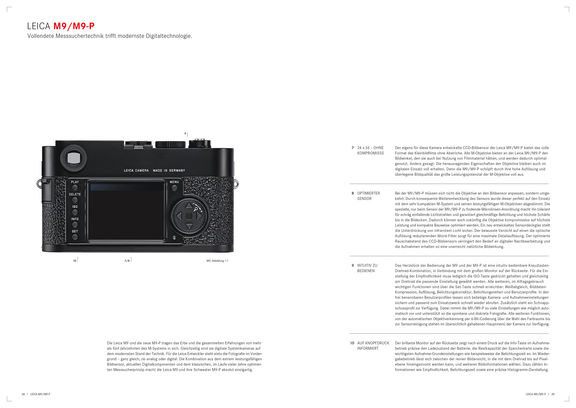
Following a short emotive introduction, the product text is more informative, summarizing the product characteristics listed below. It need not, however, go into detail about each of them. This text element serves exclusively as a concise overview of the most significant characteristics of the product that follows.
Example:
The Leica M9 and the new M9-P incorporate the heritage and amassed experience of more than 50 years of the Leica M-System. At the same time, they are digital system cameras at the absolute pinnacle of modern technology. For Leica designers, photography has always been the prime concern – no matter whether film or digital. The combination of an extremely efficient image sensor, the latest digital components and the classic viewfinder/rangefinder principle, consistently optimized over many years, make the Leica M9 and its sister model, the M9-P, absolutely unique.
Product Characteristics
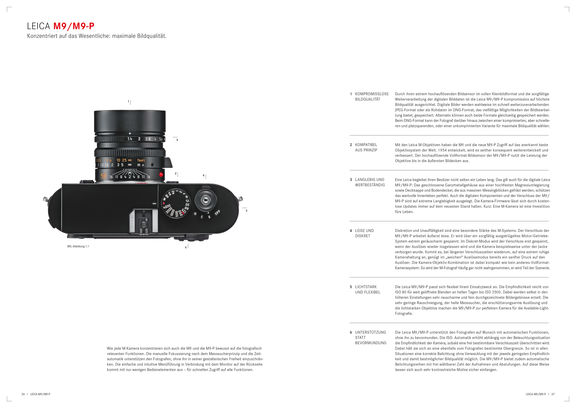
The product characteristics and features are the most informative sections in all literature. They provide a detailed description of the most significant product benefits. Each product benefit has its own product characteristics text. These are purely informative and are separated from one another by a line. They provide a factual enumeration of the most significant product characteristics. They are precise, with their length varying depending on the number of details required to describe the product benefit.
Example:
COMPATIBILITY AS A MATTER OF PRINCIPLE
Both the M9 and the new M9-P, of course, offer photographers access to the complete Leica M range of lenses, long since recognized as being the best in the world. Its develop - ment began in 1954, and the M-System has been continually advanced and impr oved ever since. The high-resolution, full-format image sensor of the M9 and M9-P fully exploits the performance of legendary Leica lenses from corner to corner.
Technical Data
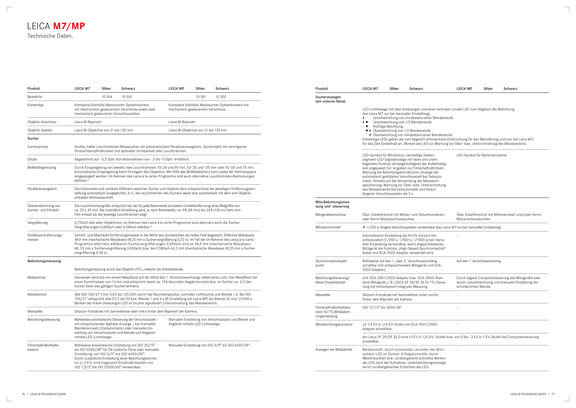
The most important technical data of the product are listed in a table at the end of the literature. Each column within the table begins with a capital letter, and a period is set at the end of the column. Only exception: No punctuation mark is set after the product description in the column header. Highlighting in bold type may be employed to improve the clarity and legibility of tables. Consecutive items are separated by commas. Product names are set in mixed case.
Examples:
Order no. 12345 (E-version), 12345 (U-version).
Zoom optical/digital 24×/4×.
Only exception:
Product Leica V-Lux 20